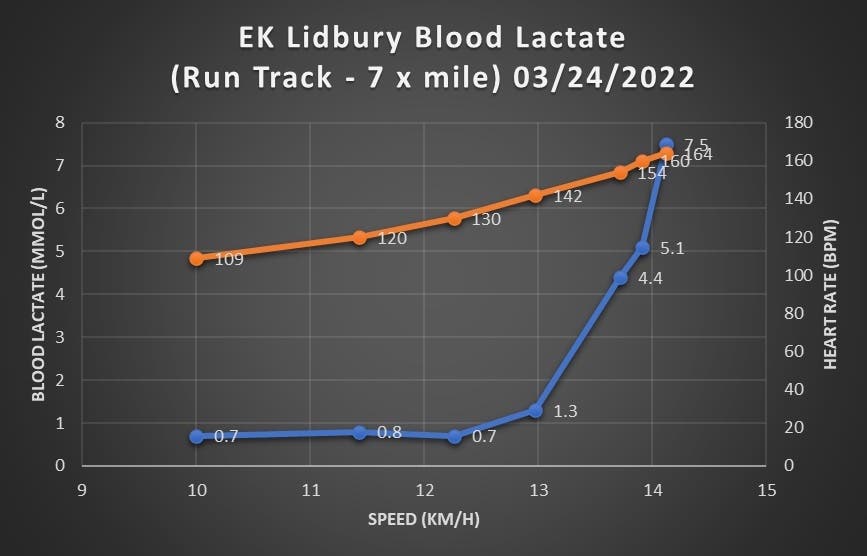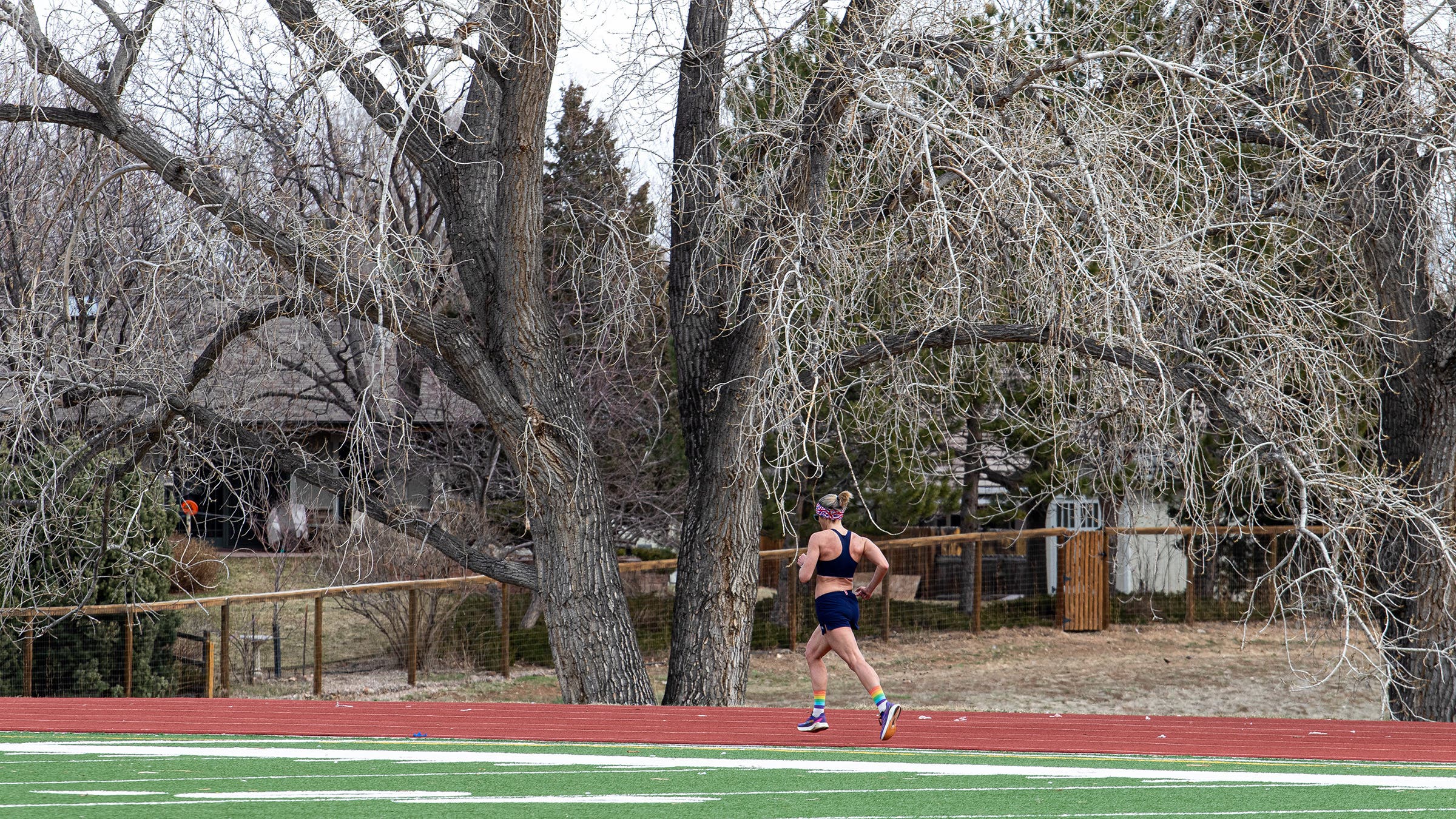Train Like a Norwegian: How It Started, How It's Going...

Emma-Kate Lidbury concludes her 7 x 1-mile lactate testing session with Alan Couzens. (Photo: Brad Kaminski)
If you’ve been following our Train Like a Norwegian experiment, you’ll already be aware that I’m following a training program inspired by the Norwegian-style of training: double threshold workout days, long easy runs, and lactate testing. For those unaware of this project, you can find out more about it here.
In short, I’m following a training program written by coach Alan Couzens in a bid to find out: What happens when you train like a Norwegian? In today’s update, we’ll be looking at the overall program plan as well as taking a closer look at the lactate testing that I undertook with Couzens back in week three of the program. Data from this testing—such as lactate levels and heart rate—was then used to write the following weeks of training. It will also serve as a point of comparison when we do a final round of testing.
RELATED: What Does It Mean to “Train Like A Norwegian?”
The program
The program began back in early March and, as I was fairly deconditioned then, Couzens included two generic weeks of “ramping in” to slowly build up volume while also introducing some key sessions that had a “Norwegian feel to them, without being the full-octane version of what’s ahead,” he said. This included two days with two run sessions per day (30 and 40 minutes in duration), as well as a 90-minute Sunday longer run, all of which was to be done at ~70% of maximum heart rate. Yoga and technique-based swims were used as active recovery sessions. Two bike workouts were also included, one of which featured higher-intensity efforts, the other was a high-cadence spin. There was one strength workout per week, as well as a short core/activation routine. Key workouts during these two weeks were deliberately conservative and, with a lactate testing session built into week three, they would be refined going forwards on the basis of the lactate testing results.
Weeks three and four were more specific, with the double threshold days starting to have more “bite.” The lactate testing session in week three involved a track workout of seven one-mile repeats with a lactate test (blood taken from thumb/index finger) between each one mile. With an estimated maximum heart rate of 170 bpm, Couzens prescribed the following:
•1 mile @ HR 110 bpm (lactate test between each one mile, no further recovery once blood was drawn)
•1 mile @ HR 120 bpm
•1 mile @ HR 130 bpm
•1 mile @ HR 140 bpm
•1 mile @ HR 150 bpm
•1 mile @ HR 160 bpm
•1 mile @ maximum effort
You can see Couzens’ full analysis of the session below (and my Strava file from the session is here). A second test session is planned in the coming weeks. The latter stages of the program (which we are currently in now) involve more challenging sessions at threshold pace, moving to longer intervals (e.g. 1K-3K repeats) plus some more intense anaerobic sessions with a view to sharpening up the higher end anaerobic systems/muscle fibers.
The test set: 7 x 1-mile repeats
The test involved seven one-mile repeats, starting at a heart rate of 110bpm and increasing by 10bpm each repeat with the ultimate goal of hitting my (estimated) maximal heart rate of 170bpm on the final effort. Recovery between each one-mile repeat was essentially the time taken to complete the lactate test (~45 seconds) track-side, and heart rate was reported at every 400m split to ensure it was on track. The data from the session is shown here:

Coach’s analysis
Couzens’ analysis and feedback from the test is below:
Once you got warmed up, your baseline lactate reached nice low levels.
You came into the test with lactate at 1.6 mmol/L, it was 1.0 mmol/L after your first 800m walk, and then you can see it continued to drop further for the initial stages down to a low of 0.7 mmol/L. This is desirable and indicates very high mitochondrial efficiency and a strong aerobic base. The Norwegians are famous for doing their easy miles below 1.0 mmol/L. For most athletes, this is prohibitive (they just can’t get that low), but for you, when jogging at ~120 bpm, your lactate is likely under this magic 1.0 mmol/L mark.
Just as importantly, your lactate stayed low a long way into the test.
Your lactate stayed flat and stable all the way to ~7:50-minute/mile pace. This was 87% of your max. speed in the test. This is a very high level for your Aerobic Threshold. The aerobic base that you’ve built over the years clearly remains very strong.
When your lactate starts to rise, it kicks quite quickly.
After you move past ~7:25-minute/mile pace and a heart rate of 142 bpm, we saw your lactate start to rise quickly. Between the two points of 1.3 and 4.4 mmol/L lies your second threshold. In that step, we jumped the heart rate and pace a little (HR 142->154, ~8-8.5mph), but given the steepness of the curve, in the interests of safety, I think it’s fair to say that the bulk of your threshold work should be taking place within the first segment of that jump (from a HR of ~142-148 bpm and a speed of ~8.0-8.5 mph/ 7:00-7:30-minute/mile pace).
From a training perspective, it makes sense to focus training on the steepest parts of the curve.
In my opinion, a threshold focus (with quality days focused in that 7:00-7:30-minute/mile range) makes a lot of sense for you.
Your anaerobic threshold also occurred at a relatively high % of your maximal speed.
Placing your second threshold in the middle of that range (~7:00-7:30-minute/mile pace) would be 95% of your maximal pace. This speaks to what you were saying about feeling as though you were missing a bit of “oomph” in the last stage. So, in addition to the threshold work, it also makes sense to continue the development of the anaerobic power to give the curve some room to grow. In training terms, this will take the form of giving hill workouts a little more “bite”—a little longer to give your body a chance to get that anaerobic glycolytic system into play, coupled with some similar sessions on the flat, at or slightly above that final stage pace (9.0-9.5 mph), especially as we get closer to your race.

RELATED: What’s the Difference Between Aerobic and Anaerobic?
“Train like a Norwegian” sample workouts
Armed with the data from the test above, here are some of the sessions that have become staples of the program:
Double Run Day 1 (early weeks of the program)
AM: Progressive Run
– 2K Easy jog @ HR <120 bpm
– 2K Build @ HR 120-140 bpm
– 2K Tempo @ HR 140 to 150 bpm
– 1K easy cooldown
PM: Threshold 10 x 400
Warm-up: 10-15 min. @ HR <120 bpm
10 x 400 @ 7:15 min/mile pace (1:48/400m) on 30 sec. rest; aiming to keep each of the reps as near as possible to this set pace in order to stay under LT2.
Cooldown: 10 min. @ HR <120 bpm
Double Run Day 2
AM: Easy Run, 3 miles, all under HR 120 (~70% of max HR)
PM: 45 min. run with 5 x 60 sec. hill repeats, building HR to 150-160 bpm (85-90% of max. HR) with 90 sec. jog recovery back to start. Pick a low to moderate grade hill (3-4%) so you can comfortably jog down. HR should hit ~150bpm (90% of max HR) at the end of first and progressively build through the series. Remaining run time should all be at HR 120 bpm or lower.
Double Day 3 (latter stages of the program)
AM: 10K with 3 x 2K @ 140-150bpm
PM: 10K with 7 x 1K @ 7:15 minute/mile pace (just under LT2)
Double Day 4 (latter stages of the program)
AM: 5K easy (all under 120bpm)
PM: 8K with 12 x 400m on 2 min. (running 1:40-1:45/400m, which is just under LT2)
Long Run Day
1 hour 45 min. all under HR 120 (70% of max. HR)
Recovery Day
45 min. yoga or 25 min. swim
RELATED: The Training Secrets Behind the Norwegians’ Phenomenal Ironman Debuts